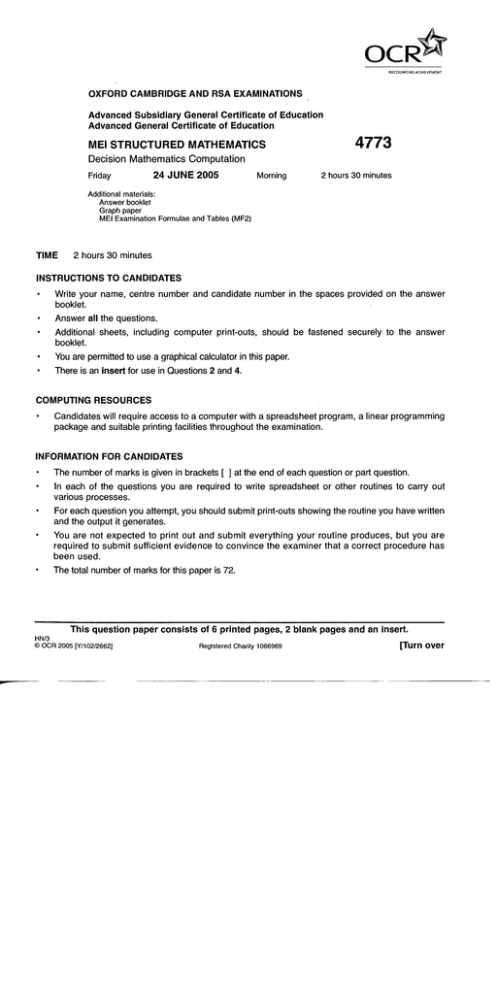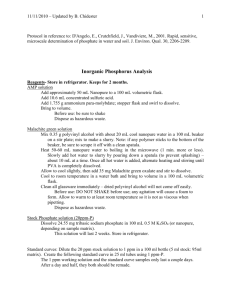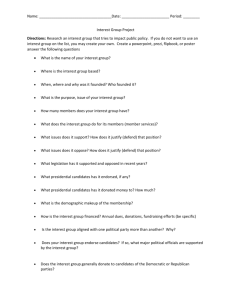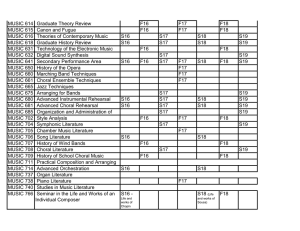Document 10489060
advertisement

Mark Scheme 4773 June 2005 Qu. 1 (i) 32*80 = 2560 calories (ii) 3000/32 = 93.75 kg (iii) Auxiliary equation is (3x−1)(3x−2) = 0 Solution is un = 13.75(1/3)n − 27.5(2/3)n + 93.75 (iv) 90 90 85.83333 81.66667 78.65741 76.80556 75.78961 75.28807 75.06873 74.98871 74.96962 74.97276 74.98119 (Oscillatory) convergence to 75 kg. (v) 90 90 82.77778 75.55556 70.33951 67.12963 65.36866 64.49931 64.11913 63.98043 63.94734 63.95278 63.9674 63.98052 M1 A1 M1 A1 M1 M1 A1 M1 A1 B1 A1 particular 93.75 or 3rd eqn gen homogeneous correct form case 1 (u0 = 80) + case 2 (u1 = 80) M1 simultaneous A1 13.75 and −27.5 B1 final answer M1 A1 B1 B1 Qu. 2 (i) E A 2 2 C 3 2 1 F 2 2 G 2 S 1 1 5 1 1 B 3 T 1 H D M1 A1 1 I (ii) 1 1 B 0 2 B1 1 and 1 B1 0 B1 2 C (iii) S B D A C G (T) M1 A1 E (iv) A 2 C 3 2 1 1 S G 1 1 4 3 D 1 1 1 B 2 1 F H T M1 A1 1 1 I (v) S B⏐A C D E F G H I T or S A B D⏐C E F G H I T M1 a cut, properly specified A1 correct cut (vi) Max SA + SB + SD st SA+CA+DA-AD-AC = 0 SB+CB+DB-BC-BD = 0 AC+BC-CA-CB-CE-CF-CG = 0 SD+BD+AD-DA-DB-DH-DI = 0 SA < 2 SB < 5 SD < 1 AD < 2 DA < 2 BC < 1 CB < 1 AC < 3 BD < 3 CA < 3 CE < 2 CF < 1 CG < 2 DB < 3 DH < 1 DI < 1 end B1 M1 A1 B1 (vii) OBJECTIVE FUNCTION VALUE 1) 6.00000 VARIABLE SA SB SD CA DA AD AC CB DB BC BD CE CF CG DH DI VALUE 2.000000 3.000000 1.000000 0.000000 1.000000 0.000000 3.000000 0.000000 0.000000 1.000000 2.000000 2.000000 0.000000 2.000000 1.000000 1.000000 REDUCED COST 0.000000 0.000000 0.000000 1.000000 0.000000 0.000000 0.000000 1.000000 0.000000 0.000000 0.000000 0.000000 0.000000 0.000000 0.000000 0.000000 M1 A1 B1 Flows are as listed in the "VALUE" column. Qu. 3 (i) Simulating service times (=lookup(rand(),cum.probs,times)) Accumulating (expectation is 207.5 seconds) B1 B1 (ii) Repetitions Mean (not far off 207.5 seconds) sd (order of magnitude 5 seconds) (2*1.96*s)2 = (about) 400 repetitions (assuming a 95% confidence interval half-width of 0.5s) B1 B1 B1 M1 A1 (iii) Rand()*120 fixed sorted M1 A1 B1 (iv) max(arrival time, gate available time) + service time finish time approx as in (i) B1 B1 B1 (v) Test barrier free times to see which barrier passenger uses. Computation of barrier free times, eg: =if(bar=1, max(arrival t + service t, bar t + service t), bar t) M1 A1 M1 A1 finish time approx 130s B1 Qu. 4 (i) Sched. City S1 L S2 L S3 L S4 L S5 B S6 B S7 B S8 B S9 B S10 B S11 M S12 M S13 M S14 P S15 P S16 P S17 P S18 P S19 P S20 P Flight City 101 B 101 B 101 B 101 B 201 P 201 P 201 P 202 M 202 M 202 M 301 P 302 L 303 B 401 B 401 B 401 B 401 B 402 M 402 M 403 L Flight City 201 P 201 P 202 M 202 M 402 M 402 M 403 L 301 P 302 L 303 B 403 L 102 B 204 M 201 P 202 M 203 P 202 M 302 L 303 B 102 B Flight City 402 M 403 L 302 L 301 P 302 L 303 B 102 B 403 L 102 B 102 204 B M 301 P 303 102 203 203 B B P P Flight City 302 L 403 102 L B 102 B 204 M 203 203 P P M1 A1 A1 A1 A1 London Berlin Milan Paris (ii) Min S1+S2+S3+S4+S5+S6+S7+S8+S9+S10+S11+S12 +S13+S14+S15+S16+S17+S18+S19+S20 st S1+S2+S3+S4>1 S5+S7+S8+S9+S11+S12+S18+S20>1 S1+S2+S5+S6+S7+S14>1 S3+S4+S8+S9+S10+S15+S17>1 S16+S17+S18+S19+S20>1 S11+S12+S13>1 S4+S8+S11+S15>1 S1+S3+S5+S9+S12+S18>1 S6+S10+S13+S17+S19>1 S14+S15+S16+S17>1 S1+S5+S6+S18+S19>1 S2+S4+S7+S8+S11+S20>1 M1 A1 objective M1 A3 (−1 each error/omission) (iii) OBJECTIVE FUNCTION VALUE 1) 3.000000 VARIABLE S1 S2 S3 S4 S5 S6 S7 S8 S9 S10 S11 S12 S13 S14 S15 S16 S17 S18 S19 S20 VALUE 1.000000 0.000000 0.000000 0.000000 0.000000 0.000000 0.000000 0.000000 0.000000 0.000000 1.000000 0.000000 0.000000 0.000000 0.000000 0.000000 1.000000 0.000000 0.000000 0.000000 REDUCED COST 0.000000 0.000000 1.000000 0.000000 0.000000 0.000000 0.000000 0.000000 1.000000 1.000000 0.000000 1.000000 1.000000 0.000000 0.000000 0.000000 0.000000 0.000000 0.000000 0.000000 3 pilots are used M1 A1 B1 (iv) Three more runs, with S1=0, S11=0 and S17=0 in turn. All require 4 pilots M1 A1 (3 runs) A1 (4 pilots) (v) B1 No account taken of pilot stress (workload/long day/short changeover) 4773 - Decision Mathematics Computation General Comments This paper was substantially the same as the paper set for 2622, and this report overlaps greatly with that for 2622. On that paper each question was marked out of 20 and candidates were required to attempt 3 out of 4 questions. The questions were reduced slightly in content for 4773, and were worth 18 marks each, but candidates were required to attempt all 4. Candidate performances on 4773 were good. There was evidence of some candidates running out of time. In a few other cases, Lindo appeared to have been used to generate a solution, but no evidence was included with the script. Candidates need to take great care in labelling their computer printout pages, ensuring that they have the correct question number on them and that they are assembled in the correct order. Comments on Individual Questions 1) Recurrence relations (i) Most candidates got this right, although some computed u2 as their answer. (ii) This was a little more difficult than part (i), and a small but significant number of candidates failed on it. (iii) A large proportion of candidates managed to find their way completely successfully through this intricate calculation. (iv)(v) Most candidates succeeded in building correct spreadsheets. Not all of those achieved full marks, failing to make simple observations about convergence and limits. 2) Networks (i) to This work on network theory was completed on the insert. It was (v) generally well done. Some candidates had difficulty with part (iii) which, for them, made part (iv) more difficult than it should have been. Nevertheless, they were able to recover since any flow pattern giving a total flow of 6 was acceptable. (vi) & Most showed a good idea of how to construct the LP model, even if (vii) mistakes were made along the way. Again, there was a weakness in extracting results from the output. 3) Simulation (i) 4) (ii) Most could do this in principle, but a significant minority made one of two mistakes – • using 0, 0.15 and 0.75 instead of 0, 0.15 and 0.9 in their lookup table • failing to accumulate the service times. • A significant minority of candidates failed to compute the standard deviation of their 10 accumulated times. In some instances candidates tried to do the computation longhand, instead of using the spreadsheet function. The majority of candidates could do the computation to determine approximately how many repetitions are required. However, it was quite common to see answers in error by a factor of 4. (iii) Almost all candidates succeeded with this. (iv) Most candidates could do this simulation, but many failed to compute the queuing times. (v) A majority could build this two-server simulation but many failed with the queuing times. A number of candidates treated the barriers as being in series rather than parallel – this of course extends rather than reduces the exit time and thus defeats the purpose of this section of the question. Others had errors in their formulae and did not appear to check their computed values for reasonableness. LP modelling (i) It was expected that there would be errors made in this part of the question. In fact, many candidates got it completely right. (ii) & Most succeeded in building and running the LP model. However, many (iii) of those who produced output failed to interpret it to say how many pilots were needed. A number of candidates missed one or two schedules from constraints and did not appear to check back through their work. (iv) Very few candidates scored any marks on this. All that was required was a systematic suppression of each of the three solution schedules in turn. In each case more than 3 pilots are required, showing that there is no alternative solution. A few candidates produced alternative, logically reasoned arguments based on permutations of 4-flight schedules, whilst others tried to base their answer on their original Lindo output. (v) Examiners do not expect candidates to show any detailed ab initio knowledge of the scenarios presented. Nothing is required beyond that which is given in the question. Thus they should not, for instance, have been worrying about the mechanics of refuelling and preparing aircraft. Indeed, there is no mention in the question about the aircraft which are used, so that can form no legitimate part of the answer. However, "turning around" a pilot certainly was relevant.







